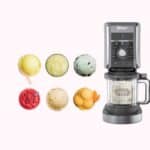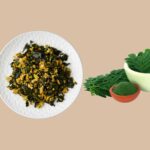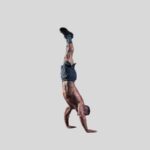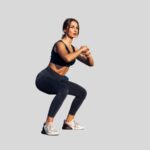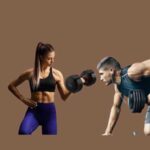In recent years, the desire for an “onion booty” has gained immense popularity, captivating the attention of fitness enthusiasts and individuals seeking a sculpted backside. When achieving a solid and well-rounded lower body, it’s essential not to neglect the glute muscles.
The glutes are vital in various movements, from walking and running to squatting and jumping. Exercises to target different glute muscles can enhance their strength and functionality, ultimately improving overall athletic performance and preventing potential injuries.
In this article, we will explore exercises that focus on the three main glute muscles: the gluteus maximus, gluteus medius, and gluteus minimus. Let’s delve into glute training and discover the best exercises for each muscle group.
Teasing The Secrets To Achieving Your Desired Posterior
In this comprehensive guide, we’ll unveil the secrets and techniques that will help you shape your glutes and unlock the potential of your booty. From understanding the anatomy of gluteal muscles to incorporating targeted exercises and implementing a well-balanced nutrition plan, we’ll cover every aspect necessary for your journey to an onion booty. So, let’s dive in!
Importance of Strong Glute Muscles
Before we delve into the exercises, let’s take a moment to understand why strong glute muscles are essential. The glute muscles, consisting of the gluteus maximus, gluteus medius, and gluteus minimus, contribute to a wide range of movements, stability, and overall lower body strength.
Exercises To Target Different Glute Muscles – An Overview Of Glute Muscles
Gluteus Maximus
The gluteus maximus is the most important muscle in the glute complex and holds immense importance in lower body movements. It plays a crucial role in hip extension, essential for running, jumping, and climbing stairs. A strong gluteus maximus enhances athletic performance and contributes to a well-balanced physique.

Understanding the Gluteus Maximus
The gluteus maximus originates from the posterior sacrum and ilium bones and inserts into the femur’s posterior surface. It acts as the primary hip extensor, working with other muscles like the hamstrings and adductors to produce powerful movements.
Benefits of Strengthening the Gluteus Maximus
Strengthening the gluteus maximus brings numerous benefits, including improved athletic performance, enhanced power output, and increased stability during lower body movements. A strong gluteus maximus also helps alleviate lower back pain by providing stability and support to the lumbar region.
Squats: Maximizing Glute Muscle Activation
Squats are one of the most effective exercises for targeting the gluteus maximus. By squatting to a parallel or below-parallel depth, you maximize the activation of the glute muscles, engaging them in a challenging and comprehensive manner.
Romanian Deadlifts: Building Glute Power
Romanian deadlifts primarily target the gluteus maximus while also engaging the hamstrings and lower back muscles. Romanian deadlifts involve hinging at the hips and lowering the barbell or dumbbells while keeping the back straight. Standing back up, you activate the gluteus maximus to drive the movement.
Glute Bridges: Activating the Gluteus Maximus
Glute bridges are a fantastic exercise for isolating and activating the gluteus maximus. Lie on your back with your knees bent and feet flat on the ground, then lift your hips off the floor while squeezing your glutes. This movement effectively engages and strengthens the gluteus maximus.
Step-Ups: Targeting Glutes and Lower Body Strength
Step-ups are excellent for targeting the gluteus maximus and lower body muscles. By stepping onto an elevated platform, you engage the glutes to lift your body weight, effectively working on glute activation and lower body strength.
Gluteus Medius
The gluteus medius is a minor muscle located on the outer surface of the pelvis. While it may not be as well-known as the gluteus maximus, it plays a vital role in stabilizing the pelvis during activities such as walking, running, and balancing on one leg.

Understanding the Gluteus Medius
The gluteus medius originates from the outer surface of the ilium, and inserts into the trochanter of the femur. Its primary function is hip abduction, which moves the leg away from the body’s midline.
Benefits of Strengthening the Gluteus Medius
Strengthening the gluteus medius offers several benefits, including improved hip stability, enhanced balance, and reduced risk of knee injuries. This muscle helps maintain proper alignment during lower body movements, preventing excessive joint stress.
Clamshells: Activating and Strengthening the Side Glutes
Clamshells are a simple yet effective exercise for activating and strengthening the gluteus medius. Lie on your side with your legs bent, then open and close your knees like a clamshell while keeping your feet together. This movement targets the side glutes and helps develop strength and stability.
Side-Lying Leg Lifts: Building Gluteus Medius Strength
Side-lying leg lifts isolate the gluteus medius by lifting the top leg while lying on your side. This exercise effectively activates and strengthens the gluteus medius, improving hip stability and balanced lower body strength.
Hip Abduction Exercises: Isolating the Gluteus Medius
Hip abduction exercises, such as using a resistance band to perform side leg lifts, specifically target the gluteus medius. You engage and strengthen the gluteus medius by putting a resistance band around your ankles and lifting one leg out to the side against the band’s resistance.
Resistance Band Walks: Strengthening the Lateral Hip Muscles
Resistance band walks are excellent for targeting the lateral hip muscles, including the gluteus medius. Keep a resistance band around your lower thighs and assume a half-squat position. Step sideways, maintaining tension on the band throughout the movement. This exercise helps strengthen the gluteus medius and improves hip stability.
10 Must-Have Fitness Gadgets Under $100
Gluteus Minimus
The gluteus minimus is the smallest of the three glute muscles and is located beneath the gluteus medius. Although small, it is crucial in hip stabilization and contributes to lower body strength.

Understanding the Gluteus Minimus
The gluteus minimus has a similar origin and insertion as the gluteus medius. It is situated beneath the gluteus medius and works synergistically with it to stabilize the hip joint during movements.
Benefits of Strengthening the Gluteus Minimus
Strengthening the gluteus minimus offers various benefits, including enhanced hip stability, improved posture, and reduced risk of hip and knee injuries. This muscle contributes to maintaining proper alignment and balance during activities that involve single-leg support.
Fire Hydrants: Activating the Gluteus Minimus
Fire hydrants are a simple and effective exercise for activating the gluteus minimus. Begin on all fours, then lift one leg out to the side, mimicking a dog’s movement at a fire hydrant. This exercise effectively engages and strengthens the gluteus minimus.
Lateral Band Walks: Targeting the Gluteus Minimus
Similar to those targeting the gluteus medius, lateral band walks also engage the gluteus minimus. Perform the exercise by stepping sideways while maintaining tension on the resistance band around your lower thighs. This movement effectively activates and strengthens the gluteus minimus.
Pilates Side Leg Lifts: Sculpting the Gluteus Minimus
Pilates side leg lifts are excellent for sculpting and strengthening the gluteus minimus. Lie on your side with your legs straight and lift the top leg towards the ceiling, focusing on engaging the gluteus minimus. This exercise helps enhance hip stability and overall lower body strength.
Fueling Your Booty Gains: Nutrition for Optimal Results

The Importance Of A Balanced Diet For Muscle Growth And Recovery:
A balanced diet is essential. Consuming various nutrient-dense foods provides your body with the necessary macronutrients and micronutrients to build and repair muscle tissue and support optimal muscle growth and recovery. You optimize your booty-building journey and achieve the best results by fueling your body with the proper nutrients.
Macronutrient Ratios: Focusing On Protein, Carbohydrates, And Healthy Fats
Maintaining the proper balance of macronutrients—protein, carbohydrates, and healthy fats is crucial for booty gains. Protein is essential for muscle repair and growth, while carbohydrates provide energy for workouts and replenish glycogen stores. Healthy fats support hormone production and aid in nutrient absorption. Balancing these macronutrients gives you the fuel to shape and develop your glutes effectively.
Foods To Support Muscle Development And Energy Levels
Incorporating specific foods into your diet can further support muscle development and energy levels. Lean proteins, such as chicken, fish, and tofu, provide essential amino acids for muscle repair. Complex carbohydrates like whole grains, fruits, and vegetables, offer sustained energy for your workouts. Healthy fats in sources like avocados, nuts, and olive oil provide crucial nutrients and support hormone production.
Hydration: The Often Overlooked Key To Overall Health And Fitness
Amidst the focus on training and nutrition, hydration is often overlooked but remains a vital component of overall health and fitness. Staying adequately hydrated supports muscle function, joint health, and overall performance. Drink sufficient water throughout the day, especially before, during, and after your workouts. Proper hydration ensures optimal muscle function and aids in the recovery process.
10 Best Infuser Water Bottles For Hydrating On The Go
The Power of Rest and Recovery
Understanding The Significance Of Rest Days For Muscle Repair
Rest and recovery are just as important as exercise regarding muscle growth and development. Rest days allow your muscles to repair and rebuild, essential for gaining strength and size. Incorporating designated rest days into your routine gives your glutes the time they need to recover and grow, ultimately leading to a more developed onion booty.
The Role Of Sleep In Muscle Growth And Overall Well-Being
Adequate sleep significantly affects muscle growth, recovery, and overall well-being. During sleep, your body undergoes essential repair processes, including releasing growth hormones and muscle tissue regeneration.
Aim for 7-9 hours of sleep each night to optimize your booty-building efforts and support your overall health and fitness goals.
Active Recovery Techniques To Enhance Blood Flow And Reduce Soreness
In addition to rest days and sleep, active recovery techniques can enhance blood flow and reduce muscle soreness. Engaging in low-intensity activities, such as yoga, swimming, or light stretching, promotes circulation, accelerates recovery, and reduces post-workout muscle soreness. Incorporating these techniques into your routine can optimize your glute development and minimize discomfort.
Embracing Consistency and Progress Tracking
The Need For Consistency And Dedication In The Booty-Building Journey
Consistency and commitment are vital to achieving your onion booty goals. Building a well-developed backside takes time and effort, and staying committed to your training and nutrition plan is essential. Establishing a consistent routine and maintaining dedication, you set yourself up for success on your booty-building journey.
Tracking Progress And Celebrating Milestones
Tracking your progress is important for staying motivated and celebrating milestones. Take measurements, photographs, or keep a training journal to monitor your glute development and overall progress.
Celebrate each milestone you reach, whether increasing your strength, noticing expanded definition, or getting a specific aesthetic goal. Recognizing your progress keeps you motivated and inspired to continue pushing forward.
The Importance Of A Positive Mindset In Achieving Long-Term Goals
Maintaining a positive mindset is vital in achieving long-term booty-building goals. The journey to developing an onion booty may have ups and downs, but a positive attitude helps you overcome challenges and stay focused on your objectives. Embrace self-compassion, patience, and a growth mindset to ensure a fulfilling and successful journey to your desired posterior.
Supplementing Your Efforts: Do’s and Don’ts
Protein Supplements: Enhancing Muscle Recovery And Growth
Protein supplements like whey protein or plant-based protein powders, can be valuable to your nutrition plan. These supplements offer a convenient and efficient way to increase protein intake, supporting muscle recovery and growth. However, it’s crucial to prioritize whole food sources of protein and use supplements as a complement rather than a replacement for a balanced diet.
Avoiding Unnecessary And Potentially Harmful Supplements
While certain supplements can aid in your booty-building journey, avoiding unnecessary and potentially harmful substances is essential. Beware of products promising unrealistic results or containing banned substances. Prioritize a well-rounded diet, adequate hydration, and consult a healthcare professional or nutritionist before incorporating supplements into your routine.
Consulting With A Healthcare Professional Or Nutritionist
Before making any significant changes to your diet or exercise routine, it’s always wise to consult with a healthcare professional or nutritionist. They can provide personalized guidance as per your individual needs and goals, ensuring you’re on the right track for developing an onion booty safely and effectively.
Addressing Common Challenges and Plateaus
Breaking Through Plateaus With Progressive Overload
Plateaus are a common challenge in any fitness journey, including booty building. Incorporate progressive overload into your training to break through plateaus and continue making progress. Gradually increase your exercise’s weight, reps, or intensity to challenge your gluteal muscles and stimulate further growth. You can overcome plateaus and unlock new booty gains by continually pushing your limits.
Overcoming Muscle Imbalances For Balanced Glute Development
Muscle imbalances can hinder your booty-building progress and lead to suboptimal results. To overcome imbalances and achieve balanced glute development, focus on exercises that target weaker areas, incorporate unilateral exercises to address asymmetry and ensure proper form and technique in all movements. You can sculpt a well-proportioned and symmetrical onion booty by paying attention to muscle imbalances.
Adjusting Workouts And Nutrition To Overcome Challenges
You may encounter various challenges in this journey, such as time constraints, injuries, or lifestyle changes. During such times, it’s essential to be adaptable and adjust your workouts and nutrition plan. Modify your exercises, find alternative options, or seek professional guidance to ensure you continue progressing towards your booty goals despite your challenges.
The Importance of Form and Technique
Ensuring Proper Exercise Form For Effective Glute Engagement
Proper exercise form is crucial for effective glute engagement and minimizing the risk of injury. Pay close attention to your posture, alignment, and range of motion during each exercise. Engage your glutes intentionally, focus on the mind-muscle connection, and avoid relying solely on momentum or compensatory movements. By prioritizing proper form, you optimize glute activation and maximize the effectiveness of your workouts.
Seeking Guidance From A Fitness Professional Or Personal Trainer
If you need more clarification on proper form or technique, seeking guidance from a fitness professional or personal trainer can be immensely beneficial. They can provide individualized instruction, correct your form, and ensure you perform exercises safely and effectively. Investing in professional guidance is an investment in your booty-building journey’s success and your long-term well-being.
The Impact Of Correct Form On Minimizing The Risk Of Injury
Correct form is essential not only for effective glute engagement but also for minimizing the risk of injury. Maintaining proper alignment, utilizing a full range of motion, and avoiding excessive stress on joints or muscles can significantly reduce the likelihood of strains, sprains, or other injuries. Prioritize your safety and well-being by prioritizing correct form in all your exercises.
Embracing Variety and Progression
The Significance Of Varying Exercises To Avoid Adaptation
To continually challenge your gluteal muscles and avoid adaptation, it’s crucial to embrace exercise variety. Regularly change your workouts, incorporate different exercises, and explore various equipment options. Introducing new stimuli keeps your muscles guessing, promotes growth, and prevents plateaus. Embrace variety to unlock the full potential of your glutes.
Implementing Progressive Overload For Continuous Muscle Growth
As mentioned earlier, progressive overload is crucial for continuous muscle growth. Implementing progressive overload involves gradually increasing the demands on your gluteal muscles over time. It can be achieved by growing weights, reps, sets, or workout frequency. By progressively challenging your glutes, you encourage ongoing muscle growth and development.
Incorporating New Techniques And Exercises To Challenge The Glutes
Incorporating new techniques and exercises into your routine is vital for challenging your glutes and avoiding stagnation. Experiment with different exercise variations, explore innovative training methods or try out new equipment. By embracing novelty, you keep your workouts fresh, exciting, and practical, ensuring your glutes continue to grow and shape into the coveted onion booty.
Maintaining Motivation and Overcoming Setbacks
Staying Motivated Throughout The Journey To An Onion Booty
Maintaining motivation throughout your booty-building journey can be challenging but crucial for long-term success. Set clear goals, create a positive environment, and find sources of inspiration that resonate with you. Surround yourself with like-minded individuals, follow fitness influencers, or join online communities to stay motivated and inspired on your quest for an onion booty.
Utilizing Visualization Techniques And Goal-Setting
Visualization techniques and goal-setting can be powerful tools in maintaining motivation and achieving your desired booty. Visualize yourself with your dream onion booty, imagine how it feels to have a solid and sculpted backside, and set specific, realistic goals to work towards. You establish a roadmap that keeps you focused and driven by visualizing your success and setting clear objectives.
Overcoming Setbacks And Staying Committed To Your Goals
Setbacks are a natural part of any fitness journey, but overcoming them and staying committed to your goals is crucial. When faced with challenges or setbacks, reassess your approach, seek support, and remember your initial motivation. Remind yourself of the progress you’ve made and the transformative potential that lies ahead. Embrace resilience and perseverance to persevere and stay committed to your booty-building goals.
Lifestyle Factors and Booty Enhancement
Addressing The Impact Of Posture On The Appearance Of The Backside
Beyond exercise and nutrition, lifestyle factors can significantly influence the appearance of your backside. Posture, in particular, plays a crucial role. Maintaining proper posture during exercise and everyday activities helps align your spine, accentuate the curves of your glutes, and contribute to an overall more lifted and visually appealing booty. Be mindful of your posture and make corrections as needed.
The Role Of Clothing And Styling In Accentuating The Booty
Clothing and styling choices can enhance the appearance of your booty by accentuating its shape and curves. Opt for high-waisted bottoms, such as leggings or jeans, that provide lift and support. Additionally, ruched or textured fabrics and strategic patterns can create the illusion of a rounder and more defined backside. Embrace fashion choices that flatter your body and make you confident in your onion booty.
Embracing A Healthy Lifestyle For Overall Body Confidence
Lastly, embracing a healthy lifestyle beyond booty-building exercises and nutrition is vital for overall body confidence. Prioritize self-care, practice stress management techniques, and cultivate a positive body image. A healthy mind and body connection contribute to your overall well-being, ensuring you radiate confidence and proudly embrace your onion booty.
Targeting All Glute Muscles
While focusing on each glute muscle is important, it’s equally crucial to collectively target all the glute muscles for balanced development and optimal results. Here are a few exercises that engage multiple glute muscles simultaneously.
Image description: Illustration of a person performing sumo squats, engaging multiple glute muscles.
Importance of Balanced Glute Development
Achieving balanced glute development ensures lower body strength, stability, and functionality. By targeting all glute muscles, you can prevent muscular imbalances, reduce the risk of injuries, and improve your performance in various activities.
Sumo Squats: Wide-Stance for Comprehensive Glute Engagement
Sumo squats involve assuming a wide stance with toes pointed outward. Doing so engages all three glute muscles, maximizing their activation and promoting balanced development.
Bulgarian Split Squats: Isolating Each Leg for Balanced Strength
Bulgarian split squats are an excellent exercise for isolating each leg and targeting all glute muscles. Stand in a split stance with one-foot elevated behind you on a bench or step. As you perform the squatting motion, you engage the glutes of both legs, ensuring balanced strength and development.
Walking Lunges: Working the Glutes and Lower Body
Walking lunges provide a comprehensive lower body workout, engaging multiple muscles, including the glutes. You activate the glute muscles with each step to stabilize and propel your body forward, resulting in improved glute strength and endurance.
Glute Kickbacks: Activating and Strengthening Glute Muscles
Glute kickbacks primarily target the gluteus maximus and gluteus medius. Starting on all fours, extend one leg backward, focusing on squeezing the glutes. This exercise effectively activates and strengthens the glute muscles.
Incorporating Weights for Greater Intensity
To further challenge and enhance your glute workouts, incorporating weights can provide a more significant stimulus for muscle growth and strength development. Here are some exercises that involve adding weights to target the glute muscles effectively.
Benefits of Adding Weights to Glute Exercises
Adding weights to your glute exercises can elevate the intensity and provide progressive overload, leading to more significant muscle development and strength gains. By challenging the glute muscles with external resistance, you encourage their growth and improve their functional capacity.
Barbell Hip Thrusts: Maximizing Glute Activation with Weight
Barbell hip thrusts are an excellent exercise for maximizing glute activation with weights. Position your upper back against a bench, place a barbell across your hips, and thrust upward, driving through your heels. This movement effectively targets the glute muscles and provides an intense stimulus for growth.
Dumbbell Lunges: Resistance Training for Glute Development
Dumbbell lunges offer a fantastic way to incorporate weights while targeting the glutes. Hold dumbbells in each hand, step forward into a lunge position, and lower your body by bending both knees. As you push back up, focus on squeezing the glutes for maximum activation and development.
Kettlebell Swings: Building Power and Strength in Glutes
Kettlebell swings are dynamic exercises that target the glutes while building power and strength. Hold a kettlebell with both hands between your legs, hinge at the hips, and explosively swing the kettlebell forward while engaging the glute muscles. This movement recruits the glutes’ power and contributes to lower body strength.
Weighted Step-Ups: Challenging the Glute Muscles with Weight
Weighted step-ups provide a challenging exercise that targets the glutes while incorporating weights. Holding dumbbells in each hand, step onto an elevated platform and drive through the heel of the leading leg to lift your body. This movement effectively engages the glutes and challenges their strength with added resistance.
Bodyweight Exercises for Glutes
While weights can benefit glute training, bodyweight exercises also offer significant advantages. They provide convenience, require minimal equipment, and are accessible to individuals at various fitness levels. Here are some bodyweight exercises that target the glutes effectively.
Benefits of Bodyweight Exercises for Glute Development
Bodyweight exercises for the glutes offer numerous benefits, including convenience, versatility, and the ability to strengthen and activate the glute muscles without additional equipment. These exercises can be performed anywhere, making them an excellent choice for those with limited resources or when traveling.
Single-Leg Glute Bridges: Intensifying Glute Activation
Single-leg glute bridges are a more advanced variation of the traditional glute bridge exercise. Lie on your back with one leg straight up, then lift your hips off the ground while squeezing your glutes. This movement intensifies glute activation and challenges each glute muscle individually.
Walking Lunges: Dynamic Bodyweight Glute Workout
As mentioned earlier, walking lunges are a versatile exercise that can be performed with body weight alone. By incorporating them into your routine, you engage the glute muscles dynamically, promoting strength, stability, and endurance.
Donkey Kicks: Strengthening Glutes without Equipment
Donkey kicks are a classic bodyweight exercise for targeting the glute muscles. Begin on all fours and kick one leg backward, focusing on squeezing the glute as you extend. This exercise effectively activates and strengthens the glute muscles, requiring no equipment.
Bulgarian Split Squat Jumps: Plyometric Glute Exercise
Bulgarian split squat jumps combine the benefits of plyometric training with glute activation. Perform a Bulgarian split squat, then explode upward, switching legs mid-air and landing softly in a lunge position. This exercise enhances glute power, strength, and explosiveness.
Pilates and Yoga for Glute Activation
In addition to traditional strength training exercises, incorporating elements of Pilates and yoga into your glute workouts can provide unique benefits. These practices focus on engaging and activating muscles mindfully while improving flexibility and body awareness. Here are some exercises and poses that target the glutes effectively.
Pilates Exercises to Engage and Strengthen Glutes
Pilates offers a range of exercises that engage and strengthen the glutes. Moves like the Pilates bridge and the Pilates leg kick series target the glutes specifically, activating them while promoting core strength and stability.
Yoga Poses for Glute Activation and Strengthening
Certain yoga poses can help activate and strengthen the glute muscles. The bridge pose is a classic yoga pose that targets the glutes while stretching the hip flexors. The Warrior II pose is another excellent pose that engages the glutes while building endurance and stability.
The Bridge Pose: Activating and Strengthening Glute Muscles
The bridge pose is the effective yoga pose that activates and strengthens the glute muscles. Lie on your back with your knees bent and feet flat on the ground. Press your feet into the floor for lifting your hips upward, engaging the glutes. Hold the pose for a few breaths before lowering your hips back down.
Warrior II Pose: Building Glute Endurance and Stability
The Warrior II pose is a powerful yoga pose that engages the glutes, building endurance and stability. Stand with your feet wide apart, turn one-foot out, and bend your front knee while keeping your back leg straight. Sink into the pose, feeling the engagement in your glutes. Hold the pose for several breaths before switching sides.
CrossFit Exercises for Glute Development
CrossFit training is known for its high-intensity workouts that target multiple muscle groups simultaneously. It offers various exercises that can effectively engage and develop the glutes. Incorporating these exercises into your routine can lead to significant glute strength and power gains.
CrossFit Benefits for Glute Strength and Power
CrossFit workouts combine cardiovascular conditioning, strength training, and functional movements that engage the glute muscles. The intensity and variety of CrossFit exercises contribute to enhanced glute strength, power, and overall athletic performance.
Box Jumps: Explosive Glute Power in CrossFit
Box jumps are a staple CrossFit exercise that requires explosive power from the glutes. Start by standing in front of the sturdy box or platform. Explosively jump onto the box, landing with soft knees and engaging the glutes to control the movement. Step down carefully and repeat for multiple reps.
Deadlifts: Full-Body Exercise with Emphasis on Glutes
Deadlifts are a compound exercise that targets several muscle groups, including the glutes. This full-body movement requires lifting a barbell or other weighted object from the ground by extending your hips. The glutes play a significant role in the hip extension phase of the exercise, making deadlifts an excellent choice for glute development.
Wall Balls: Combining Squat and Glute Activation in CrossFit
Wall balls involve squatting while throwing a weighted ball against a wall. This exercise combines the activation of the glutes through the squatting motion with the explosive power required to throw the ball. It challenges the glute muscles while providing a cardiovascular element to the workout.
Pistol Squats: Advanced Glute Exercise in CrossFit
Pistol squats are advanced glute exercises requiring exceptional strength, balance, and mobility. This exercise involves squatting on one leg while extending the other straight forward. Pistol squats engage the glutes intensely and help develop single-leg strength and stability.
A Word From Blogzah
Regular glute training is crucial for lower body strength, stability, and functionality. You can strengthen and develop these muscles by targeting different glute muscles through specific exercises.
Whether you choose traditional strength training exercises, bodyweight movements, Pilates and yoga, or CrossFit workouts, incorporating various exercises will provide a well-rounded glute workout plan. Remember to progress gradually, maintain proper form, and listen to your body. With consistency and dedication, a well-rounded glute workout plan yields optimal results, helping you unlock your full athletic potential.



